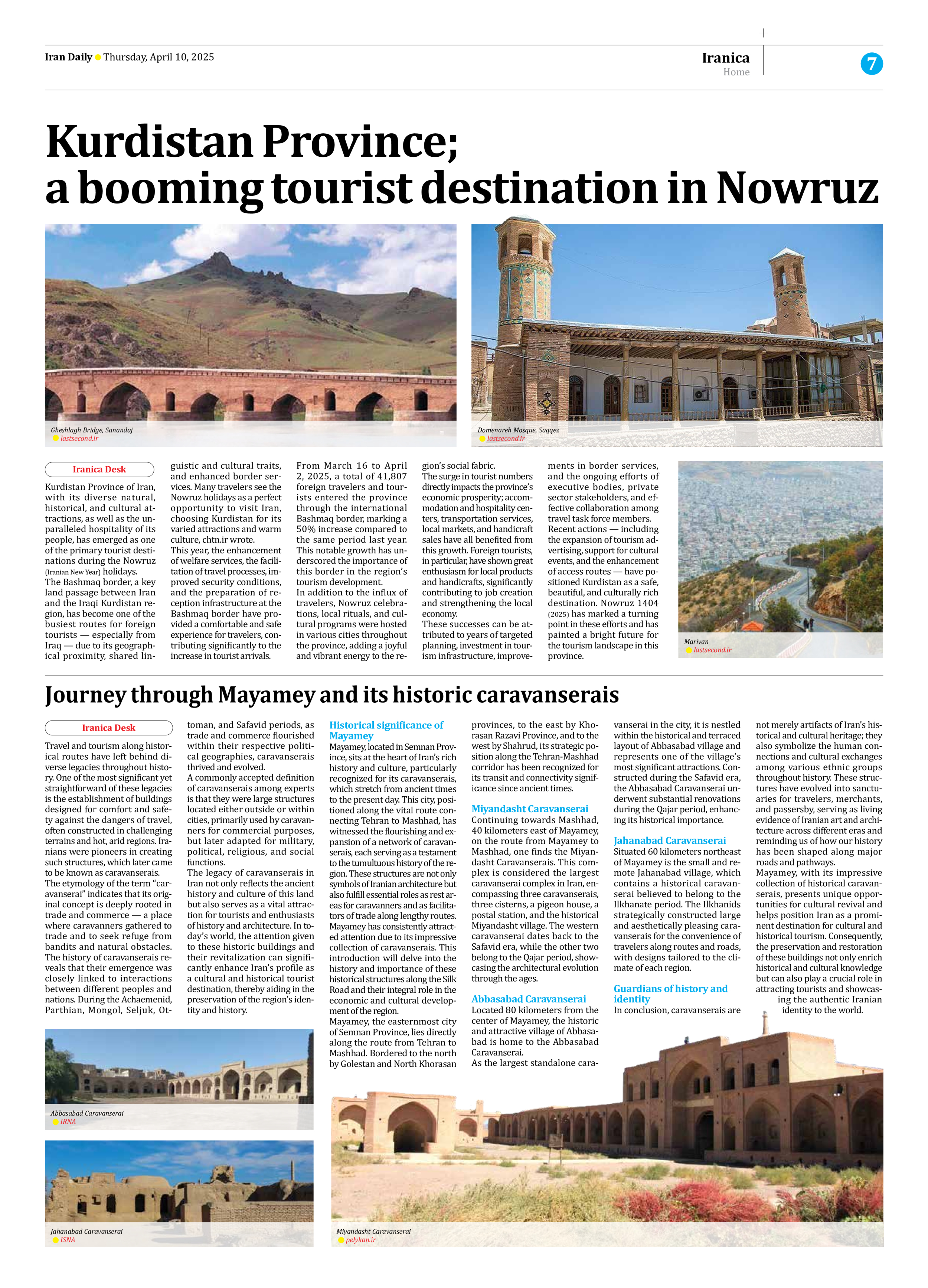
Journey through Mayamey and its historic caravanserais
Travel and tourism along historical routes have left behind diverse legacies throughout history. One of the most significant yet straightforward of these legacies is the establishment of buildings designed for comfort and safety against the dangers of travel, often constructed in challenging terrains and hot, arid regions. Iranians were pioneers in creating such structures, which later came to be known as caravanserais.
The etymology of the term “caravanserai” indicates that its original concept is deeply rooted in trade and commerce — a place where caravanners gathered to trade and to seek refuge from bandits and natural obstacles. The history of caravanserais reveals that their emergence was closely linked to interactions between different peoples and nations. During the Achaemenid, Parthian, Mongol, Seljuk, Ottoman, and Safavid periods, as trade and commerce flourished within their respective political geographies, caravanserais thrived and evolved.
A commonly accepted definition of caravanserais among experts is that they were large structures located either outside or within cities, primarily used by caravanners for commercial purposes, but later adapted for military, political, religious, and social functions.
The legacy of caravanserais in Iran not only reflects the ancient history and culture of this land but also serves as a vital attraction for tourists and enthusiasts of history and architecture. In today’s world, the attention given to these historic buildings and their revitalization can significantly enhance Iran’s profile as a cultural and historical tourist destination, thereby aiding in the preservation of the region’s identity and history.
Historical significance of Mayamey
Mayamey, located in Semnan Province, sits at the heart of Iran’s rich history and culture, particularly recognized for its caravanserais, which stretch from ancient times to the present day. This city, positioned along the vital route connecting Tehran to Mashhad, has witnessed the flourishing and expansion of a network of caravanserais, each serving as a testament to the tumultuous history of the region. These structures are not only symbols of Iranian architecture but also fulfill essential roles as rest areas for caravanners and as facilitators of trade along lengthy routes. Mayamey has consistently attracted attention due to its impressive collection of caravanserais. This introduction will delve into the history and importance of these historical structures along the Silk Road and their integral role in the economic and cultural development of the region.
Mayamey, the easternmost city of Semnan Province, lies directly along the route from Tehran to Mashhad. Bordered to the north by Golestan and North Khorasan provinces, to the east by Khorasan Razavi Province, and to the west by Shahrud, its strategic position along the Tehran-Mashhad corridor has been recognized for its transit and connectivity significance since ancient times.
Miyandasht Caravanserai
Continuing towards Mashhad, 40 kilometers east of Mayamey, on the route from Mayamey to Mashhad, one finds the Miyandasht Caravanserais. This complex is considered the largest caravanserai complex in Iran, encompassing three caravanserais, three cisterns, a pigeon house, a postal station, and the historical Miyandasht village. The western caravanserai dates back to the Safavid era, while the other two belong to the Qajar period, showcasing the architectural evolution through the ages.
Abbasabad Caravanserai
Located 80 kilometers from the center of Mayamey, the historic and attractive village of Abbasabad is home to the Abbasabad Caravanserai.
As the largest standalone caravanserai in the city, it is nestled within the historical and terraced layout of Abbasabad village and represents one of the village’s most significant attractions. Constructed during the Safavid era, the Abbasabad Caravanserai underwent substantial renovations during the Qajar period, enhancing its historical importance.
Jahanabad Caravanserai
Situated 60 kilometers northeast of Mayamey is the small and remote Jahanabad village, which contains a historical caravanserai believed to belong to the Ilkhanate period. The Ilkhanids strategically constructed large and aesthetically pleasing caravanserais for the convenience of travelers along routes and roads, with designs tailored to the climate of each region.
Guardians of history and identity
In conclusion, caravanserais are not merely artifacts of Iran’s historical and cultural heritage; they also symbolize the human connections and cultural exchanges among various ethnic groups throughout history. These structures have evolved into sanctuaries for travelers, merchants, and passersby, serving as living evidence of Iranian art and architecture across different eras and reminding us of how our history has been shaped along major roads and pathways.
Mayamey, with its impressive collection of historical caravanserais, presents unique opportunities for cultural revival and helps position Iran as a prominent destination for cultural and historical tourism. Consequently, the preservation and restoration of these buildings not only enrich historical and cultural knowledge but can also play a crucial role in attracting tourists and showcasing the authentic Iranian identity to the world.







